![]()
![]()
![]()
Use LEFT and RIGHT arrow keys to navigate between flashcards;
Use UP and DOWN arrow keys to flip the card;
H to show hint;
A reads text to speech;
39 Cards in this Set
- Front
- Back

|
Mineralisaton of the Endocardium
- can be with fibrosis - due to ->excessive intake of Vit D ->intoxication by calcinogenic plants in cows -> hyperparathyroidism -> renal failure -> Johne's disease Fibrosis occurs in chronic dilated hearts, healed ulcerative endocarditis in dog (uraemia) and in jet lesions (valvular stenosis) Grossly - Multiple, large, rough, white, firm plaques of fibroelastic mineralised tissue are present in the endocaridum and intima of large elastic arteries. |
|

Canine
|
Severe Endocardial Mineralisation
of valvular and trabecular region Uraemia mineralisation |
|
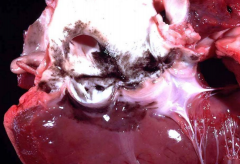
Sheep
|
Endocardial Pigmentation due to melanosis in calves and lambs
Sheep - Melanosis of aortic valves |
|
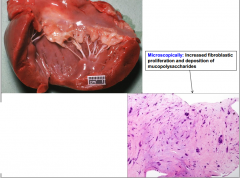
Cavalier King Charles Spaniel
|
Valvular Endocardiosis
- age related cardiac diaease of small and toy breeds (CKCS) - associated with the degeneration of valvular collagen - polygenic basis - affected valves are shortened and thickened (nodular) and appear smooth and shiny - these lesions result in valvular insufficiency and congestive heart failure - development of jet lesions and rupture of chordae tendeniae are common Microscopically -Increased fibroblastic proliferation and deposition of mucopolysaccharides |
|
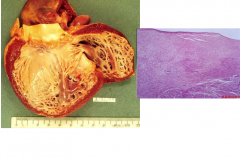
Siamese / Burmese
|
Seen in Siamese / Bumese
- defect in the myocardial lymph drainage, leading to chronic oedema and fibroelastic tissue proliferation - reduced myocaridal function - reduction in output - can incarcerate subendocardial Purkinje fibers which leading to left bundle branch block |
|
|
Endocarditis
|
Often due to:
-endothelial injury -stasis of blood flow -hypercoagulability. -Pre existing extracardiac infections leading to Haematogenous dissemination (bacteria>parasites>fungi) -> Pigs - Streptocccus & E.rhusiopathiae -> Cattle - Arcanobacterium pyogenes -> Dog & Cats - Streptoccocus & E.coli Valves affected mitral>aortic>tricuspid> pulmonary Grossly - the surface is rough and granular, with large adhering, friable, yellow/grey masses (vegetations) Microscopically - fibrin, platelets, bacteria, leukocytes and erythrocytes - in chronic lesions, the fibrin deposits are organized by fibrous connective tissue to produce irregular nodular masses that can become mineralised. |
|
|
Pathogenesis of Endocarditis
|
•Extracardiac infection that have resulted in one or more bouts of bacteriemia
• Injuried valves allows bacteria to adhere, proliferate and initiate an imflammatory reaction. • Death is the result of cardiac failure from valvular dysfunction, bacteraemia or presence of septic emboli leading to infarction or abcess formation in other organs (lungs, kidneys). |
|
|
Ulcerative Endocarditis
|
Uraemia (acute renal insufficiency) induce endocardial ulceration in dogs
Grossly - after initital ulcer heals, the area is replaced by raised, white plaques of fibrous and mineralised tissue |
|
|
Right Cardiac Endocarditis
|
Stenosis of right valve, chronic hepatic congestion and pulmonary embolism
|
|
|
Left Cardiac Endocarditis
|
Stenosis of left valve, chronic pulmonary congestion
and systemic embolism (kidney) |
|
|
Which Side of the Heart is Endocarditis most likely to occur in a Dog
|
Left
70:30 |
|
|
Which Side of the Heart is Endocarditis most likely to occur in a Cat
|
Both Left and Right are RARE
|
|
|
Which Side of the Heart is Endocarditis most likely to occur in a Horse
|
Right -> 100%
|
|
|
Which Side of the Heart is Endocarditis most likely to occur in a Cow
|
Right
77:23 |
|
|
Which Side of the Heart is Endocarditis most likely to occur in a Pig
|
Left
80:20 |
|
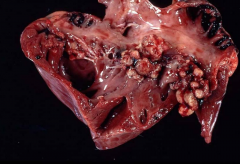
Pig
|
Endocarditis valvularis thromboticans
caused by -> Staphylococcus aureus |
|

Llama
|
Vegetative Polypous Endocarditis
Caused by -Streptococcus, Staphylococcus, Escherichia coli, Klebsiella |
|
|
Sequelae to Endocarditis
|
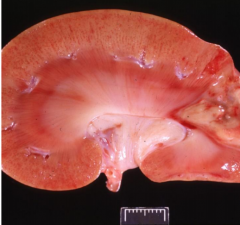
If it is bacterial causes - septic emboli can break off and disseminated throughout the whole body
Embolic showers, multifocal purulent lesions scattered randomly throughout the organ (kidney) |
|
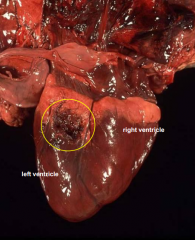
|
Traumatic Rupute of the Myocardium
this example is in a deer that was shot through the heart in the left ventricle |
|
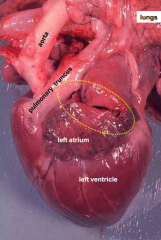
Dog
|
Left Atrium
Spontaneous rupture and chronic left atrial dilation possibly due to the insufficiency of mitral valve. |
|
|
Ventricular Hypertrophy
|
- • Represents an reversible increase in muscle mass (increase in size of muscle cells).
• Secondary as a result of a compensatory response to increase workload. • However, primary hypertrophy also occurs (irreversible idiopathic hypertrophic cardiomyopathy). |
|
|
Eccentric Ventricular Hypertrophy
|
• Heart with normal/enlarged ventricular chambers
• Walls of increased thickness • It is produced by lesions that increase blood volume load, such as valvular insufficiencies and septal defects. |
|
|
Concentric Ventricular Hypertrophy
|
• Heart with small ventricular chambers that have thick walls.
• It is produced by lesions that increase pressure load, such as valvular stenosis or systemic hypertension or pulmonary disease. |
|
|
Ventricular Dilation
|
Same causes as those of hypertrophy in the presence of a myocardium which cannot undergo hypertrophy because of insufficient time, inadequate nutrition or diseases.
• Terminal lesion in many cardiac diseases. • It is a compensatory response to achieve increased cardiac output. • Dilation allows stretching of cardiac muscle cells to increase contractile force and increases stroke volume is the result. |
|
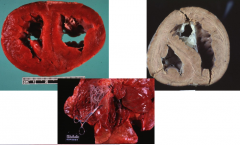
|
Right Ventricular Hypertrophy
due to p increase flow resistance in pulmonary circulation -Dirofilariosis and congenital pulmonic stenosis in dogs High altitude disease (pulmonary hypertension) in cattle Chronic alveolar enphysema in horses (heaves) |
|
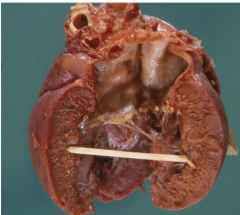
|
Left Ventricular Hypertrophy
due to - Systemic hypertension (chronic renal failure) - Congenital Subaortic stenosis |
|

Cats
|
Hypertrophic Cardiomyopathy
- common in young adult to middle ages cats (1-3) - Cats die from left atrial thrombosis and caudal aorta thromboembolism (saddle thrombosis) - Uncommon in dogs, may occur in larger breeds Gross- Hearts are enlarged and have a prominent concentric hypertrophy of the left ventricle and interventricular septum and dilation of the left atrium. |
|
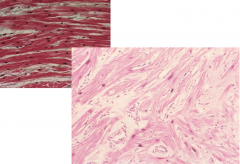
Cats
|
Histo of Hypertrophic Cardiomyopathy
-Prominent disarrays of hypertrophic degenerated myocytes with interweaving rather than parallel arrangement of fibers and interstitial fibrosis. |
|
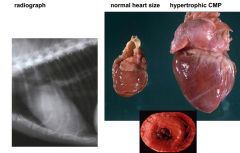
Cat
|
Hypertrophic Cardiomyopathy
|
|
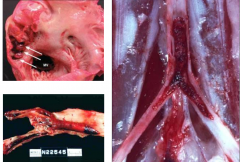
Cat
|
atrial thrombosis
saddle thrombosis concentric cardiomyopathy |
|
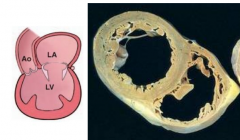
|
Dilated or Congestive Cardiomyopathy
- middle aged dogs -> due to idiopathic reasons or autosomal recessive X linked mode of inheritance. - cats -> with low tissue concentrations of taurine. Taurine. Increased taurine in commercial diets has resulting in a dramatic decrease in case numbers in the recent years. Gross -Biventricular dilation with white thickened endocardium Histo -Interstitial fibrosis, fatty infiltration and myocyte degeneration, attenuated wavy fibres |
|

Canine
|
Dilated Cardiomyopathy
|
|
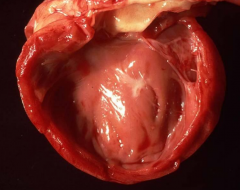
Feline
|
Dilated Cardiomyopathy
|
|
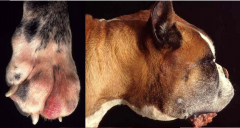
|
Clincial Signs of Dilated Caridomyopathy
-dyspnoea -anorexia -hydropericardium / hydrothroax / ascites - chronic congestion in liver and lungs - |
|
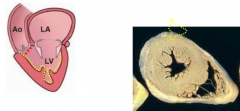
|
Restrictive Cardiomyopathy
-walls are rigid and the heart is restrcited from stretching and filling properly with blood - rhythmicity and contractiblity of the heart may be normal, but the stiff walls of the heart stop adequate chamber filling Cats with endocardial lesions (inflam, fibrosis, fibroelastosis) that impair ventricular flow - Mild increased in absolute heart weight (20g) - Short / irregular chordae taeniae - abnormal cross bar like muscular or connective tissue located in the left ventricle ("Crista saliens" red dashed line in pic) in the dog, pig and cat. |
|
|
Specific Heart Muscle Diseases
|
Mutation in genes that encodes sarcomeric proteins of cardiac myocytes (myosin, cardiac troponin, actin, ventricular myosin…) leading to structural alterations of the sarcomeres.
Shortening in the telomeres triggering apoptosis of cardiac muscle cells and leading to fibrosis. Cardiac calcium regulating proteins (phospholamban), leading to functional alterations. |
|

Golden Retriever
|
X-linked Muscular Dystrophy
-fatal - raised creatine kinase levels - muscular atrophy - mineralisation -fibrosis with fatty infiltration -disruption of skeletal and cardiac muscles' dystophin-glyocprotein complex |
|
|
Myocardial Necrosis
|
Death from acute cardiac failure, necrosis related
arrhythmias when cardiac conduction is disrupted or cardiac decompensation, cardiac dilation and congestive heart failure. -Ischemia -> hypoxia - Nutritional Deficiencies -> Vit e / Se deficiency (calves lambs and foals) -> mulberry heart disease in pigs -Capture Myopathy -> innophore toxicity - monensin intoxication -> thallium intoxication - dogs eat rodenticides -> plant intoxication -avocado intox in sheep & goats -> Doxirubicin - dogs - treatment of lymphosarcoma (depression of cardiac function, direct injury to muscle fibres and hypersensitivity reactions) |
|
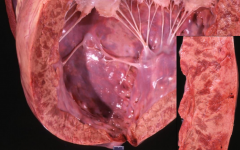
|
Myocardial Necrosis
Gross Affected areas are pale yellow to white and are dry They can become gritty to dystrophic calcification |

